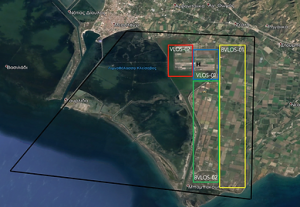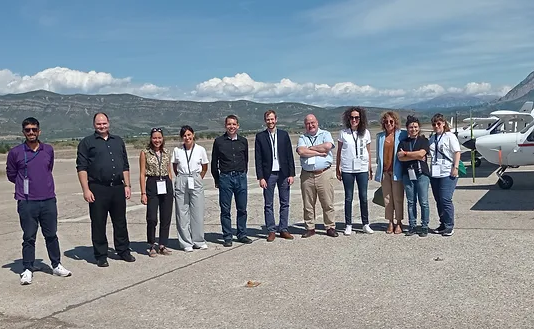The Hellenic Droneport facility in Messolonghi was inaugurated at the end of September, the first in South East Europe, aimed at supporting a holistic Advanced Air Mobility (AAM) and U-space ecosystem. Any organisation, company or individual can use the Hellenic Droneport as a testbed in European national or commercial projects.
The Hellenic U-Space Institute (ΗUSI) and Future Needs, both partners of the SAFIR-Med project, organised an executive event at the airport of the historic Greek city of Messolonghi to present to the stakeholders the location for drone testing, flights and research.
According to the SAFIR-Med press release, the Hellenic Droneport is the perfect testbed for the testing and validation of new technologies and the training of drone pilots. It is a great opportunity for operators to connect to an ecosystem of innovative companies and gain access to testing grounds for novel concepts and technological development. This site in the Messolonghi airport is a uniquely appropriate space for experimentation, providing users with all the amenities and safety measures of an aerodrome without the intensive airspace restrictions present in similar spaces due to little air traffic, as well as an unpopulated ground area, adjacent only to sparsely populated communities and ground morphology that ensures safe take-off and landing even in the presence of potential technical issues.
During the event, the mayor of the city of Messolonghi, Konstantinos Lyros welcomed the attendants, pointing out the importance of the Hellenic Droneport for the Greek U-Space, and Antigoni Karahaliou from the Hellenic Civil Aviation Authority, talked about the role of HCAA in the Greek airspace, the unmanned air zones that have been recently established in Greece and the regulation issues that come up. Moreover Robin Garrity, Senior External Affairs Officer at SESAR Joint Undertaking, underlined the importance of the input all relevant European organisations and companies have provided to SESAR, in order to produce a solid drone regulation plan for the EU airspace and emphasized the difficulties of the coexistence of manned and unmanned aviation in the same environment at the same time with safety being on top of everything. He applauded the initiative to create a Droneport space in Greece and wished all good luck with the next steps.
On behalf of HUSI, Afroditi Sakellaropoulou, UAS Legal Research & Business Development Manager for the Hellenic U-Space Institute, talked about ensuring the sustainability of advanced air mobility, explained the extent to which drones are currently used in Greece and initiated discourse on future AAM applications in the country, having consideration of the populace, national regulations, potential obstacles and aids.
Last but not least, the AgentFly Technologies Team had the opportunity, to share an insightful presentation demonstrating the simulation of medical flights in the cities of Prague and Athens – a task they work on together with HUSI and Future Needs in the SAFIR-Med project. The AgentFly Technologies CEO, Mr. Premysl Volf and CTO, Mr Millan Rollo, both senior researchers at the Czeck Technical University in Prague, explained how software simulations play an essential role in evaluating various aspects of drone integration into shared airspace. The simulations model complex urban environments (including surface, buildings, and restricted airspaces) using digital twins of drones and U-space services. According to the researchers, the simulation can run thousands of scenarios with hundreds of drones to assess key metrics like capacity under various conditions, and can be connected to existing U-space systems (e.g., C2C system) and perform benchmark tests by a large volume of virtual drones injected into the system.
The event produced discussions on Advanced Air Mobility and the importance of engaging the ecosystem in its entirety, including Operators, Manufacturers, Service Providers, Regulatory Authorities and most importantly the public.

Contact details: info@uspace.gr
For more information:




